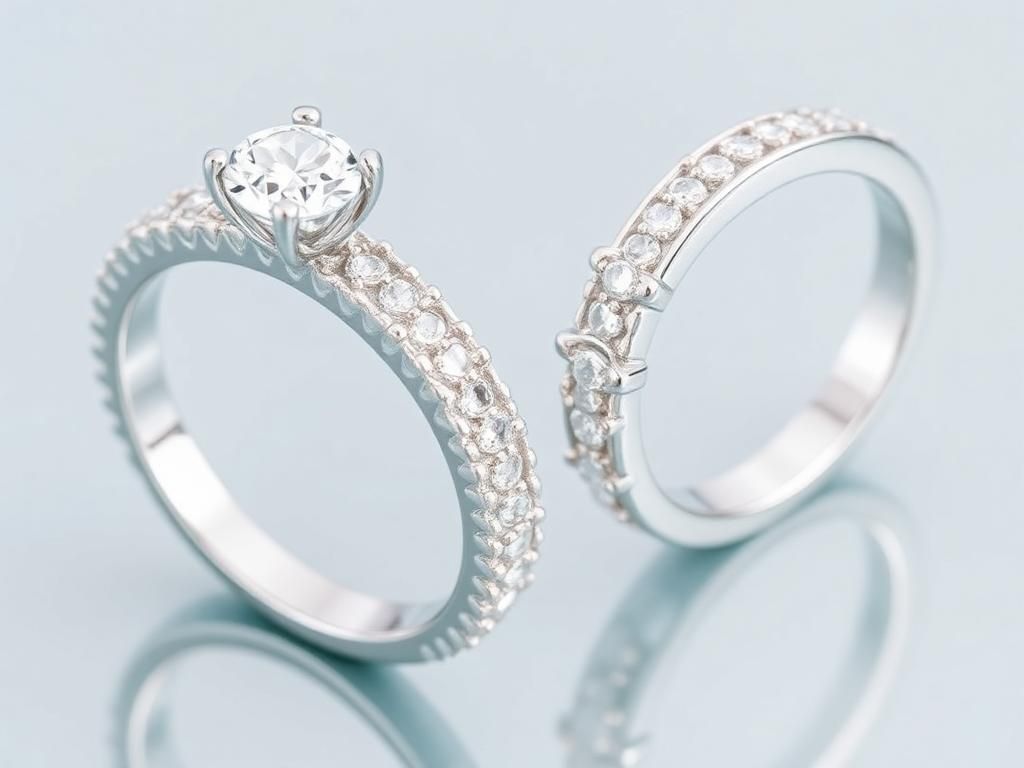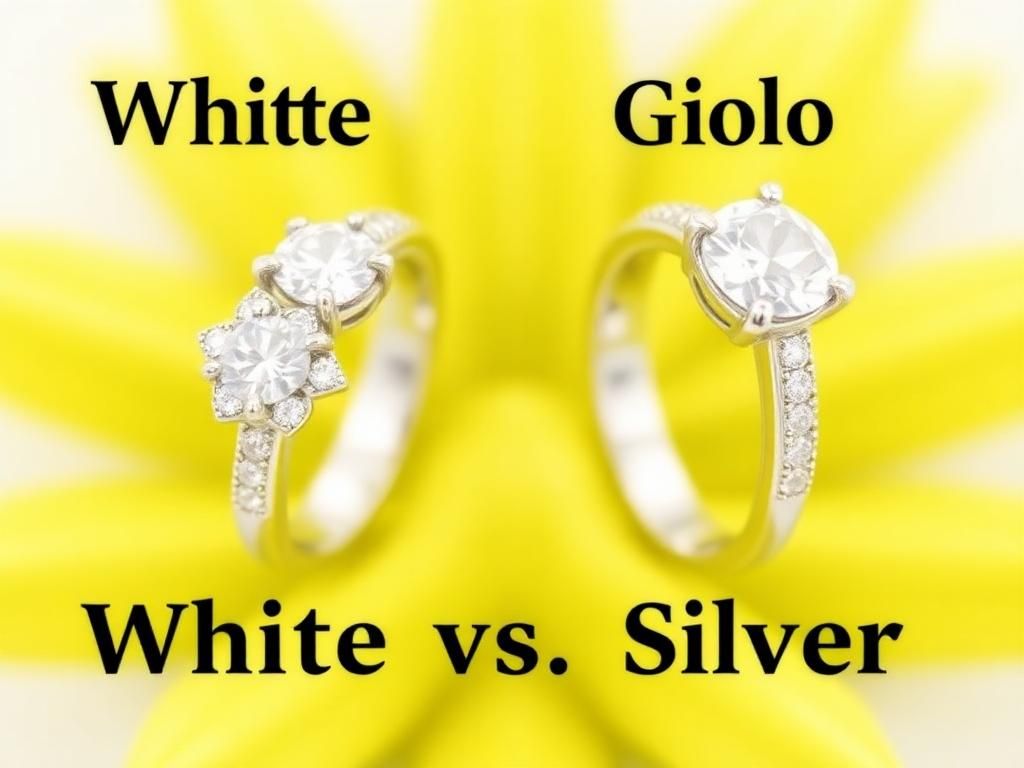Jewelry has adorned humanity for centuries, serving as expressions of love, fashion, and even social status. A significant part of that aesthetic appeal lies in the choice of metal. Among the most popular options are white gold and silver. This article delves into the intricacies of white gold vs silver, exploring their characteristics, uses, and benefits.
What is White Gold?
Definition and Composition
White gold is not a naturally occurring metal; rather, it’s an alloy, typically comprising yellow gold mixed with other metals. The most common metals used in its creation include palladium, nickel, and sometimes silver. This combination helps to enhance its durability and change its color, giving it a beautiful silvery appearance.
White gold is often available in different karats, with 14k and 18k being the most popular. The karat value signifies the percentage of pure gold in the alloy—14k contains 58.3% gold, while 18k has 75% gold content.
Appearance and Characteristics
One of the defining features of white gold is its lustrous sheen. It presents a modern look, often associated with elegance and sophistication. The alloy’s durability comes from the mix of metals, which grants it a hardness that is suitable for daily wear.
To achieve a mirror-like finish, white gold is often plated with rhodium, a precious metal that enhances its shine and increases corrosion resistance. However, this plating can wear off over time, and periodic re-plating may be required to maintain its appealing luster.
What is Silver?
Definition and Types
Silver is a naturally occurring metal known for its distinct brilliance. The two primary types utilized in jewelry are sterling silver and fine silver. While fine silver is composed of 99.9% silver, sterling silver is an alloy consisting of 92.5% silver mixed with 7.5% of other metals—usually copper—to enhance its strength.
Appearance and Characteristics
Silver has a natural shiny appearance that can be quite striking. However, it is important to note that silver is prone to tarnishing due to its reaction with air and moisture. This can diminish its shine, necessitating regular cleaning and maintenance.
When it comes to weight, silver is generally lighter than white gold. This difference can impact the overall feel of the jewelry when worn.
Comparing Properties
Durability
While both white gold and silver have their merits, they differ notably in durability. White gold is more scratch-resistant compared to silver, making it a preferable choice for items that are worn regularly, like engagement and wedding rings. Silver, though beautiful, can dent and scratch more easily, requiring more careful handling.
In terms of long-term wear and tear, white gold generally outlasts silver, maintaining its aesthetic appeal over time.
Maintenance and Care
Maintenance is crucial for both types of jewelry. Cleaning white gold typically involves gentle polishing with a soft cloth, and it’s recommended to have rhodium plating re-applied annually or bi-annually depending on wear.
On the other hand, silver requires regular polishing to avoid tarnishing. Anti-tarnish cloths can help maintain its luster, as can storing it in a cool, dry place away from air exposure.
Price Comparison
Cost Factors
When examining prices, silver is generally more affordable compared to white gold. The market price of silver fluctuates, but it often remains significantly lower than the cost of gold due to their different valuations. Additionally, the craftsmanship involved in creating jewelry—including brand reputation—can influence pricing for both metals.

Investment Value
From an investment perspective, white gold tends to retain its value better than silver. This is mainly due to the intrinsic value of the gold component in the alloy. Moreover, market trends indicate that while silver has its place, white gold jewelry generally commands a better resale value.
Jewelry Applications
Popular Styles and Usage
Both metals find diverse applications in the jewelry industry. White gold is the preferred choice for engagement rings and wedding bands, while silver jewelry is often favored for artisan pieces and more casual wear. The preference generally depends on the occasion and personal taste.
Suitability for Skin Types
Those with sensitive skin may find white gold a better option, particularly if it is alloyed with palladium, as it can be hypoallergenic. On the other hand, many people experience skin reactions to nickel, which is often present in white gold alloys. Conversely, sterling silver can cause reactions in some individuals, particularly those with sensitivities to copper.
Environmental Factors
Sourcing and Mining
The environmental impact of mining for gold and silver has garnered increasing attention. The process of mining can have adverse effects on ecosystems and communities. As such, ethical sourcing has become a key concern for consumers demanding more transparency in how these metals are procured. Sustainable practices are evolving, with more companies committed to responsible mining.
Recycling and Sustainability
Both white gold and silver offer opportunities for recycling. The recycling of metals not only conserves natural resources but significantly reduces environmental impact. The jewelry industry is beginning to embrace more sustainable practices, ensuring that consumers can make choices that align with their values.
Table of Key Differences between White Gold and Silver
| Criteria | White Gold | Silver |
|---|---|---|
| Composition | Gold alloy with metals like palladium, nickel | Sterling silver (92.5% silver), fine silver (99.9% silver) |
| Appearance | Modern and shiny, often rhodium-plated | Natural, bright but can tarnish |
| Durability | Highly durable, scratch-resistant | Less durable, more prone to scratches |
| Maintenance | Periodic rhodium plating required | Regular polishing to prevent tarnish |
| Price | Generally more expensive | More affordable |
| Investment Value | Higher resale value, stores value well | Lower resale value, less stable |
Conclusion
When weighing your options in the debate of white gold vs silver, it’s essential to consider the differences and similarities in durability, maintenance, and suitability for your lifestyle. White gold may sometimes be the superior choice for those seeking long-lasting jewelry with investment value, while silver offers a unique charm and budget-friendliness. Ultimately, the choice between these two stunning metals is about personal preference and individual needs.

Call to Action
Ready to explore your options? Dive deeper into the world of jewelry, and discover the metal that suits your style and budget. For more insightful content, check out resources like Gemsociety for further information on silver and gold.
FAQ Section
1. What is the difference between white gold and silver?
White gold is an alloy of gold and other metals, while silver is a pure metal with various compositions (like sterling). White gold tends to be more durable and pricier than silver.
2. Is white gold better than silver?
It depends on personal preference. White gold is more durable and has better resale value, while silver can be more affordable and is lightweight.
3. How do I maintain my silver jewelry?
Regular polishing with a cloth designed for silver, and storing in a dry place can help prevent tarnishing.
4. Can I wear white gold if I’m allergic to nickel?
It depends on the specific alloy used; some white gold is alloyed with nickel, which may cause reactions. Look for nickel-free options.
5. Is rhodium plating necessary for white gold?
While not strictly necessary, rhodium plating enhances the appearance and durability of white gold, making it worthwhile for long-lasting shine.
6. How does tarnish form on silver?
Tarnish develops when silver reacts with sulfur compounds in the air, which occurs with exposure to moisture and air over time.
7. Can white gold be recycled?
Yes, white gold can be recycled, making it a sustainable option in jewelry production!
8. Is sterling silver or fine silver better?
Sterling silver is more durable and suitable for everyday use, while fine silver is softer and more malleable.
9. What types of jewelry items are made from white gold?
Common items include engagement rings, wedding bands, necklaces, and earrings.
10. Which metal is best for sensitive skin?
White gold can be a good choice, particularly if it is nickel-free. However, some people may still react to the alloys, so testing is advisable.